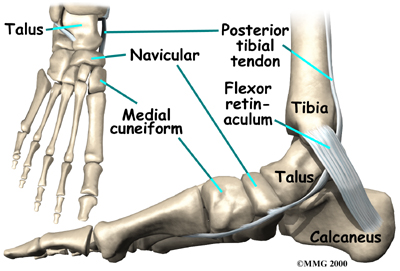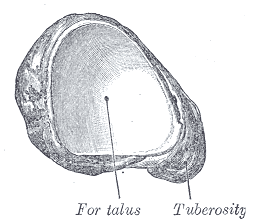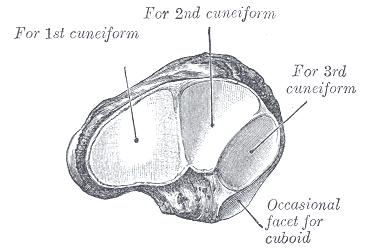Navicular stress syndrome: Difference between revisions
Sazia Queyam (talk | contribs) mNo edit summary |
Sazia Queyam (talk | contribs) m (Added content CRA) |
||
| Line 4: | Line 4: | ||
=== INTRODUCTION === | === INTRODUCTION === | ||
The Navicular is an intermediate tarsal bone on the medial side of the foot<ref>D.Richard, V.Wayne, M. Adam, Gray’s Anatomy for Students. Spain: Elsevier Publishers, 2005</ref>. Its name '''(''os naviculare pedis; scaphoid bone'')''' derives from the human bone's resemblance to a small boat. It articulates with ''four'' bones: the talus and the three cuneiforms; occasionally with a fifth, the cuboid. | The Navicular is an intermediate tarsal bone on the medial side of the foot<ref>D.Richard, V.Wayne, M. Adam, Gray’s Anatomy for Students. Spain: Elsevier Publishers, 2005</ref>. Its name '''(''os naviculare pedis; scaphoid bone'')''' derives from the human bone's resemblance to a small boat. It articulates with ''four'' bones: the talus and the three cuneiforms; occasionally with a fifth, the cuboid. | ||
While rare in the general population, stress fractures of the tarsal navicular bone are frequently incurred by professional athletes.<ref>Shakked RJ, Walters EE, O’Malley MJ. [https://www.ncbi.nlm.nih.gov/pmc/articles/PMC5344863/ Tarsal navicular stress fractures.] Current reviews in musculoskeletal medicine. 2017 Mar 1;10(1):122-30.</ref> | |||
[[File:Foot accessory navicular CLINICAL ANATOMY 1 anat01.jpg|left|Navicular Bone.|frame]][[File:Navicular bone articulation PM.gif|The left navicular. Postero-medial view.|center|frame]][[File:Navicular Bone Articulation.gif|The left navicular. Antero-lateral view.|none|frame]] | [[File:Foot accessory navicular CLINICAL ANATOMY 1 anat01.jpg|left|Navicular Bone.|frame]][[File:Navicular bone articulation PM.gif|The left navicular. Postero-medial view.|center|frame]][[File:Navicular Bone Articulation.gif|The left navicular. Antero-lateral view.|none|frame]] | ||
| Line 13: | Line 14: | ||
=== CLINICALLY RELEVANT ANATOMY === | === CLINICALLY RELEVANT ANATOMY === | ||
The navicular unique anatomic location subjects it to medial and lateral compression forces from the first and second meta-tarso-cuneiform joints, respectively. While the medial forces are shared with the talar head, the lateral forces are borne by the navicular alone. As a result of this unequal distribution of forces, maximum sheer stress is concentrated at the central third of the bone. Moreover, contraction of the tibialis posterior tendon, which inserts on the navicular’s medial tuberosity elevates the medial stress experienced by the navicular. With repeated compression of the navicular such as during running, the majority of forces are concentrated at the center of the bone, causing the navicular to be repeatedly “bent” at the avascular zone. | |||
=== REFERENCES === | === REFERENCES === | ||
<references /> | <references /> | ||
__INDEX__ | __INDEX__ | ||
Revision as of 20:28, 15 December 2018
-----PAGE IS UNDER CONSTRUCTION----
INTRODUCTION[edit | edit source]
The Navicular is an intermediate tarsal bone on the medial side of the foot[1]. Its name (os naviculare pedis; scaphoid bone) derives from the human bone's resemblance to a small boat. It articulates with four bones: the talus and the three cuneiforms; occasionally with a fifth, the cuboid.
While rare in the general population, stress fractures of the tarsal navicular bone are frequently incurred by professional athletes.[2]
CLINICALLY RELEVANT ANATOMY[edit | edit source]
The navicular unique anatomic location subjects it to medial and lateral compression forces from the first and second meta-tarso-cuneiform joints, respectively. While the medial forces are shared with the talar head, the lateral forces are borne by the navicular alone. As a result of this unequal distribution of forces, maximum sheer stress is concentrated at the central third of the bone. Moreover, contraction of the tibialis posterior tendon, which inserts on the navicular’s medial tuberosity elevates the medial stress experienced by the navicular. With repeated compression of the navicular such as during running, the majority of forces are concentrated at the center of the bone, causing the navicular to be repeatedly “bent” at the avascular zone.
REFERENCES[edit | edit source]
- ↑ D.Richard, V.Wayne, M. Adam, Gray’s Anatomy for Students. Spain: Elsevier Publishers, 2005
- ↑ Shakked RJ, Walters EE, O’Malley MJ. Tarsal navicular stress fractures. Current reviews in musculoskeletal medicine. 2017 Mar 1;10(1):122-30.









